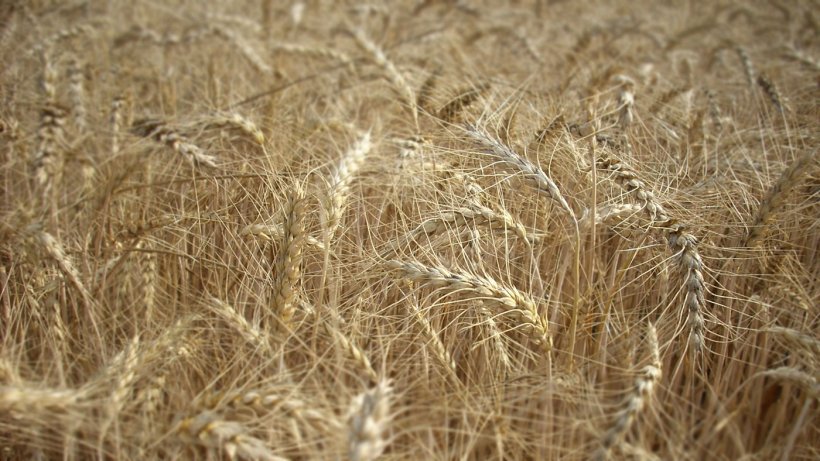Many feed ingredients in diets for pigs are high in fiber and because pigs are not particularly efficient in fermenting dietary fiber, a number of fiber degrading enzymes are available for inclusion in diets for pigs. However, as is the case for all enzymes, it is important that the specific enzymes are matched to the substrate and because of the wide variability in types of fibers included in diets for pigs, not all carbohydrases are equally suitable for all diets. The three main fibers in cereal grains and cereal grain co-products are arabinoxylans, cellulose, and mixed-linked beta glucans. The structures and fermentability are very different among these three types of fiber
Arabinoxylans

Arabinoxylans often make up 50 to 60% of all the fiber in cereal grains and cereal grain co-products. Arabinoxylans consist of a backbone of xylose and there are sidechains of arabinose, galactose, and acetyl groups attached to the backbone. In some instances, phenolic acids such as ferrulic acid and coumaric acid are attached to the side chains and this enables a link between arabinoxylans and lignin. To increase fermentability of arabinoxylans, the enzyme endo-xylanase is often added to diets fed to pigs. However, specifically in diets based on maize or maize co-products, positive responses to addition of xylanase have been difficult to demonstrate, whereas energy digestibility often is increased if xylanase is added to wheat-based diets. The reason for this difference may be that endo-xylanase only hydrolyses bonds between the xylose units in the back bone, but not the bonds in the side chains. It is believed that microbes in the hindgut have low capacity for synthesizing the enzyme arabinofuranosidase, which is needed to hydrolyze the ester bond linking two arabinose units in the sidechain. It may, therefore, be important to also add arabinofuranosidase to the diets. Lignin is a major barrier for fermentation and to increase fermentability of arabinoxylans it is important to remove the phenolic acids from the side chains because they link to the lignin. This may be accomplished by addition of esterases that hydrolyze the bond between the arabinoxylan sidechain and ferrulic acid or coumaric acid. Thus, by adding both arabinofuranosidase, ferrulic acid esterase, and coumaric acid esterase along with endo-xylanase to diets, the chance of increased fiber fermentation is enhanced.
Cellulose
Cellulose is the other major fiber component in cereal grains and it often comprises 20 to 30% of the total fiber in cereal grains. Cellulose is a homopolysaccharide that only contains glucose and it consists of crystalline regions and amorphous regions. In the crystalline regions, the long linear chains of glucose units are closely packed and anchored by hydrogen bonds, which makes fermentation almost impossible. In contrast, in the amorphous regions, the glucose chains are less closely packed and it is, therefore, possible that these regions can be fermented. The enzymes endoglucanase, exoglucanase and beta-glucosidase are needed for fermentation of the amorphous cellulose, but it is believed that all 3 of these enzymes are produced by the hindgut microflora and the amorphous cellulose is therefore partly fermented by pigs. Whether or not this fermentation may be increased by addition of exogenous enzymes is not known, but cellulose degrading enzymes are usually not included in diets for pigs although some of the so-called enzyme cocktails may contain the endo-glucanases needed to hydrolyze the beta-1.4 bonds between glucose units in cellulose.
Mixed linked beta-glugans
Mixed linked beta-glucans that are present in some cereal grains and grain co-products are less closely packed than the long glucose units in cellulose because the beta 1.3 linkages inserts kinks in the glucose chains, which prevents close packaging among adjacent chains. It takes 2 enzymes, endo beta 1.3 glucanase, and endo beta 1.4 glucanase, to hydrolyze the bonds in mixed linked beta glucans and both of these enzymes are expressed by the microbiota in the hindgut of pigs. As a consequence, mixed linked beta-glucans are almost entirely fermented in the hindgut of pigs and it is not necessary to add exogenous sources of these enzymes to the diets.
Conclusion
Arabinoxylans and cellulose make up 70 to 80 % of the fiber in most cereal grains and cereal grain co-products. Because arabinoxylan is the most dominating component in these fibers, most of the development of exogenous carbohydrate degrading enzymes has focused on this component. However, a successful degradation of arabinoxylans likely include not only a xylanase enzyme to hydrolyze the ester bonds between the xylose units in the backbone. A greater hydrolysis is likely obtained if de debranching enzymes arabinofuranosidase, ferrulic acid esterase, and coumaric acid esterase are also included in the mixture. Cellulose degrading enzymes are usually not included in diets for pigs due to limited effectiveness, and enzymes to degrade mixed linked beta-glucans are not needed because hindgut microbes express the enzymes needed for hydrolysis of these components.




